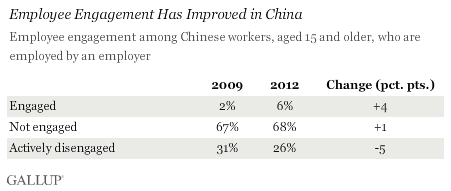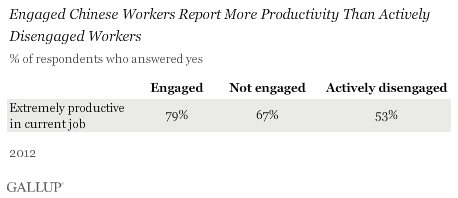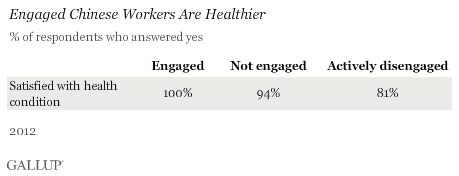WASHINGTON, D.C. -- Six percent of Chinese workers were engaged in their jobs in 2012, up from 2% in 2009. Fewer workers in 2012 were actively disengaged -- meaning fewer were emotionally disconnected from their work and workplace.

Despite the improvement, engagement in China is still low compared with the global average of 11% that Gallup measured in 2009.
Gallup's employee engagement index is based on extensive research on actionable workplace elements with proven linkages to performance outcomes, including productivity, customer service, product quality, employee retention, safety, and profitability. To measure these workplace elements, Gallup uses the survey questions to sort workers into one of three categories: engaged, not engaged, or actively disengaged. Gallup has studied employee engagement worldwide, and regardless of unique cultural and economic situations, a great workplace, defined as one where employee engagement is high, is positively correlated with a list of desirable outcomes for both employers and employees. And this positive correlation between employee engagement and desirable outcomes continues to be true in China.
For example, engaged Chinese workers are much more likely to report they are extremely productive in their current job (79%) than are those who are not engaged (67%) or are actively disengaged (53%).

Engaged employees in China are also much more likely than those who are not to rate their lives highly enough to be considered thriving.

Gallup measures how respondents evaluate their lives, both now and in five years, on the Cantril Self-Anchoring Striving Scale, where zero represents the worst possible life and 10 represents the best possible life. Gallup classifies respondents as "thriving" if they rate their current life a 7 or higher and their future life an 8 or higher. Respondents are classified as "suffering" if they rate their current life 0 to 4 and their future life 0 to 4. Those who are neither thriving nor suffering are classified as "struggling." Gallup does not ask respondents to classify their lives according to these labels.
Further, engaged workers in China report more positive experiences such as feeling well-rested, smiling or laughter, and learning interesting things as well as fewer negative emotions such as stress.

Chinese workers who are engaged in their jobs are also more likely than those who are not to say they are satisfied with their health. This is particularly important for workplaces because higher satisfaction with personal health can lead to lower absenteeism, reduced healthcare costs, and greater productivity.

Implications
Chinese workers were slightly more likely to be engaged in their jobs in 2012 than they were in the past. But, at 6%, employee engagement in the country still lags behind the worldwide average. Additionally, previous Gallup research has found that Chinese workers are among the least likely in Asia to see their job as ideal, suggesting that they are less likely to go above and beyond for their employer.
As China works to restructure its economy -- moving away from low-value added, low-skill manufacturing jobs to knowledge-intensive and innovation-oriented high-skill jobs -- measuring and managing workers' productivity will be increasingly challenging. And with more service-oriented jobs becoming available, employers need to be more proactive in motivating and engaging their employees to bring out the best to gain and keep as many customers as possible.
A steady rise in worker compensation levels has accompanied China's economic growth in the past decade -- a trend that appears to have accelerated recently. Without a concomitant rise in labor productivity, the increase in salaries could lead to a steady decline in international competitiveness. Employers in China can no longer rely solely on compensation, but need to seek alternative solutions such as employee engagement to improve productivity and maintain a competitive edge.
Although China's economic growth in the past decade has been stellar by world standards, the nation's well-being has been mostly stagnant and has only recently has shown some improvement. While the Chinese government may not be able to directly influence every individual's well-being, companies in China can and should play a key role in engaging their employees because creating an engaging workplace is positively correlated with higher well-being and better health.
For complete data sets or custom research from the more than 150 countries Gallup continually surveys, please contact us.
Survey Methods
Results are based on face-to-face interviews and landline telephone calls with approximately 9,413 adults, aged 15 and older, conducted in 2012. For results based on the Chinese working adults, one can say with 95% confidence that the maximum margin of sampling error is ±2.6 percentage points. Margin of error for engaged, not engaged, and actively disengaged employee groups are ±11, ±3, and ±5 percentage points. The margin of error reflects the influence of data weighting. In addition to sampling error, question wording and practical difficulties in conducting surveys can introduce error or bias into the findings of public opinion polls.
For more complete methodology and specific survey dates, please review Gallup's Country Data Set details.
